Listen:
Check out all episodes on the My Favorite Mistake main page.
My guest for Episode #281 of the My Favorite Mistake podcast is Dr. Edward Feinberg, a distinguished expert in restorative dentistry who has dedicated over 40 years to advancing dental care. Dr. Feinberg graduated from Tufts University, was trained by his father, Dr. Elliot Feinberg, a pioneer in full coverage restorative dentistry, and practiced in Scarsdale, New York, before moving to Arizona, where he now practices.
He is the Director of ONWARD, an online teaching organization for full coverage restorative dentistry, where he has created over 30 courses and provides a wealth of educational resources.
A nationally recognized lecturer and author, Dr. Feinberg has contributed significantly to dental literature, including his essay collection, “Open Wide: Essays on Challenges in Dentistry to Achieve Excellence.” He also serves on editorial boards and councils for various dental associations and has been honored with numerous awards for his contributions to the field.
In this episode, Ed shares insights from over 40 years in the field and discusses his unique approach to saving teeth, which contrasts with the widespread practice of extracting teeth and opting for implants. Dr. Feinberg’s “favorite mistake” involved a crown falling off a colleague’s tooth—a rare but impactful error. Through this experience, he reinforced his belief in trial-based dentistry and using precise techniques to ensure long-lasting dental solutions.
Dr. Feinberg advocates for saving teeth first, using crowns and bridges when appropriate, and stresses that implants should only be used when absolutely necessary. The conversation also touches on the overuse of implants in modern dentistry, the importance of prevention, and learning from mistakes to improve patient care.
Questions and Topics:
- What would you say is your favorite mistake?
- Was that the first time a crown had fallen off, or was it just a rare occurrence?
- Were you able to implement any checks or mistake-proofing to prevent this from happening again?
- Can you explain the difference between focusing on the tooth structure above the gum versus below the gum?
- How do you use temporary crowns, and why do some fall out while others don’t?
- Do you believe dental education is keeping up with advancements in restorative techniques?
- What are your thoughts on the current trends in implant dentistry?
- Do you think a lot of dentists are making mistakes with implants, and why?
- Are there preventive or mistake-proofing methods you apply in your practice to avoid common dental issues?
- Why do you think patients typically don’t seek second opinions in dentistry, unlike in medicine?
- Does the overuse of implants lead to malpractice cases or trouble with insurance?
- Why are patients quick to judge dentists based on superficial factors rather than their actual dental work?
- What are your thoughts on veneers—are they purely cosmetic, and when are they appropriate?
- How can dentists better manage biomechanical stress when performing implant procedures?
- Are there concerns about the future reputation of dentistry due to inappropriate practices?
- What advice would you give to patients about prevention and the importance of regular dental hygiene visits?
Key Topics Discussed:
- Dr. Feinberg’s favorite mistake: A crown falling off a colleague’s tooth and the lessons he learned about precision and correcting errors.
- Restorative dentistry techniques: Focusing on the root structure below the gum for crown and bridgework to ensure long-lasting results.
- The overuse of implants: Dr. Feinberg discusses the inappropriate use of implants and his preference for saving teeth when possible.
- Dental education: Concerns that dental schools are not teaching the best restorative methods and the influence of economic pressures on young dentists.
- Precision attachments: A less common, effective alternative to implants that can save teeth, especially for complex cases.
- Patient care and trust: How patients often judge dentists on superficial factors and the importance of second opinions in dental treatment.
- Preventive care: The importance of regular hygiene visits to prevent periodontal bone loss, which is crucial for long-term dental health.
Scroll down to find:
- Video version of the episode
- How to subscribe
- Quotes
- Full transcript
Find Ed on social media:
Video of the Episode:
Quotes:
Click on an image for a larger view
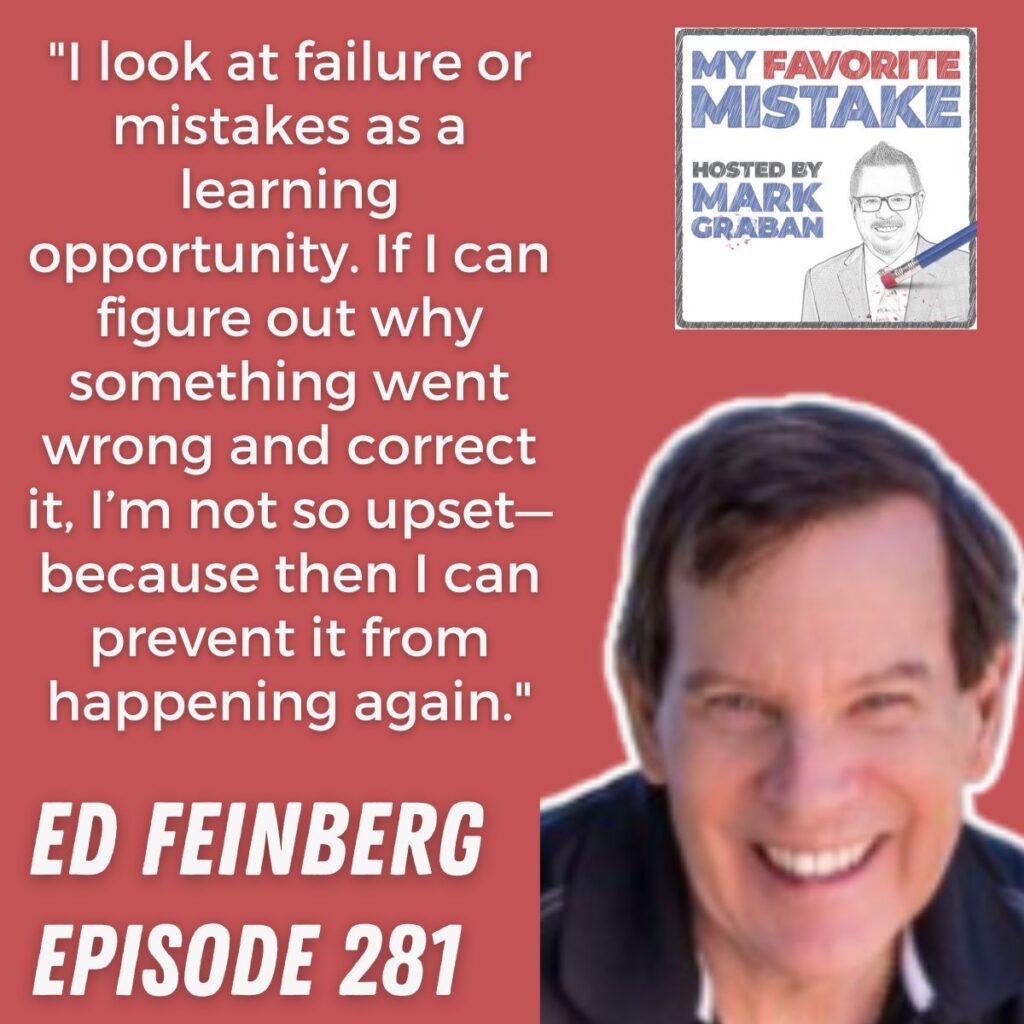
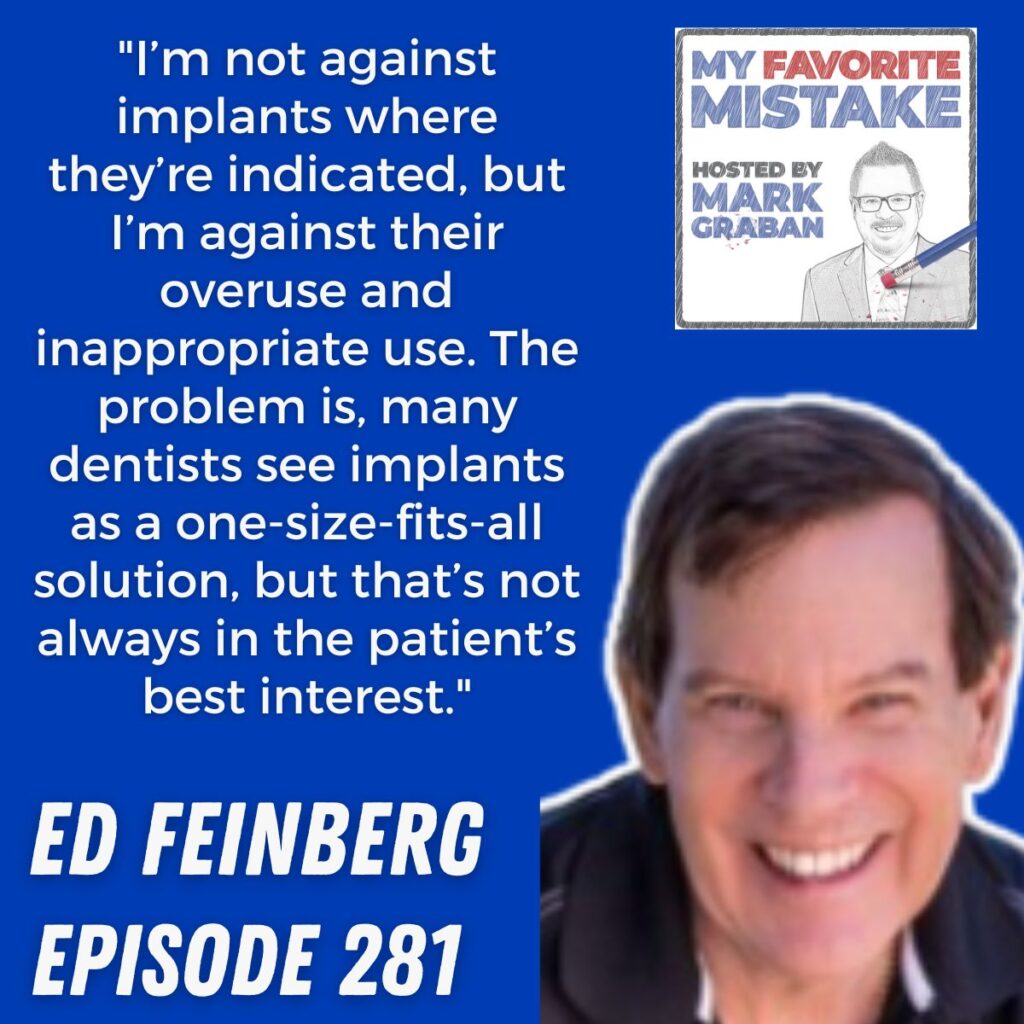
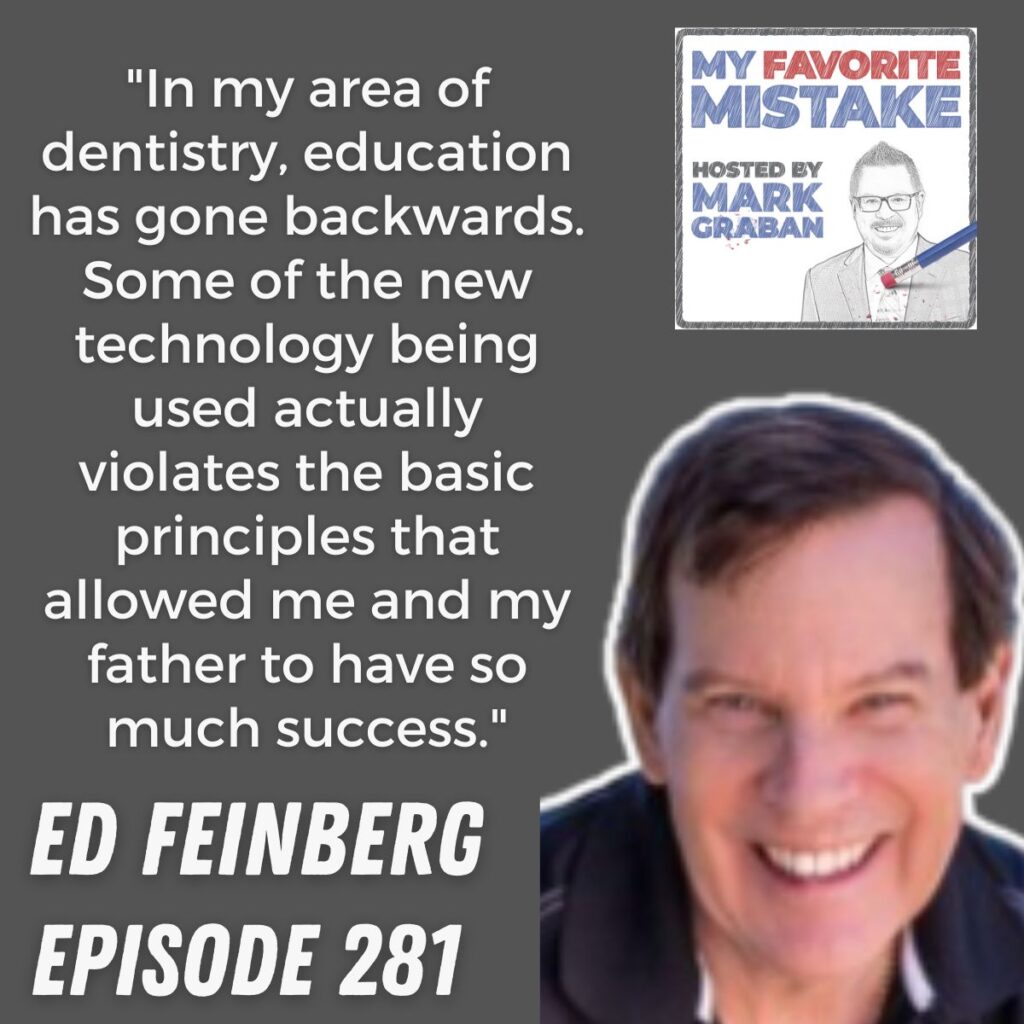
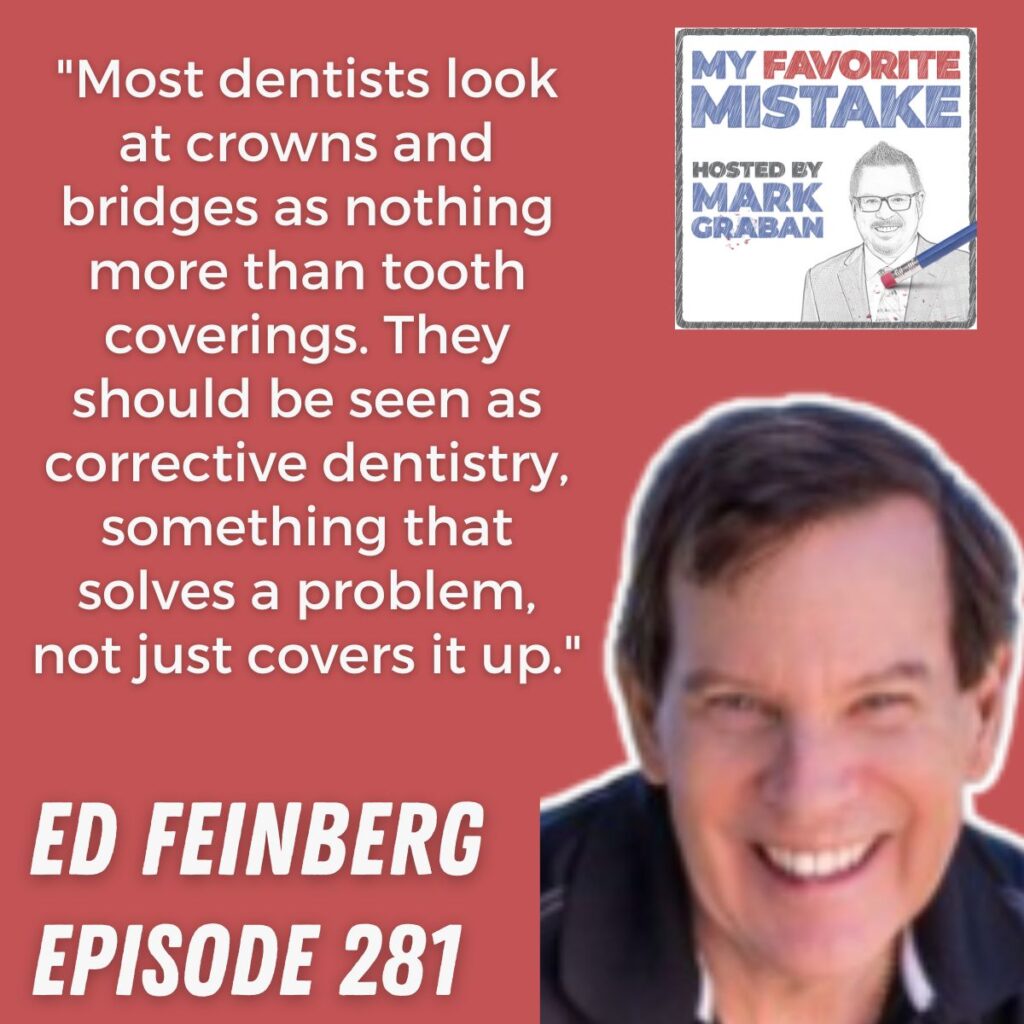
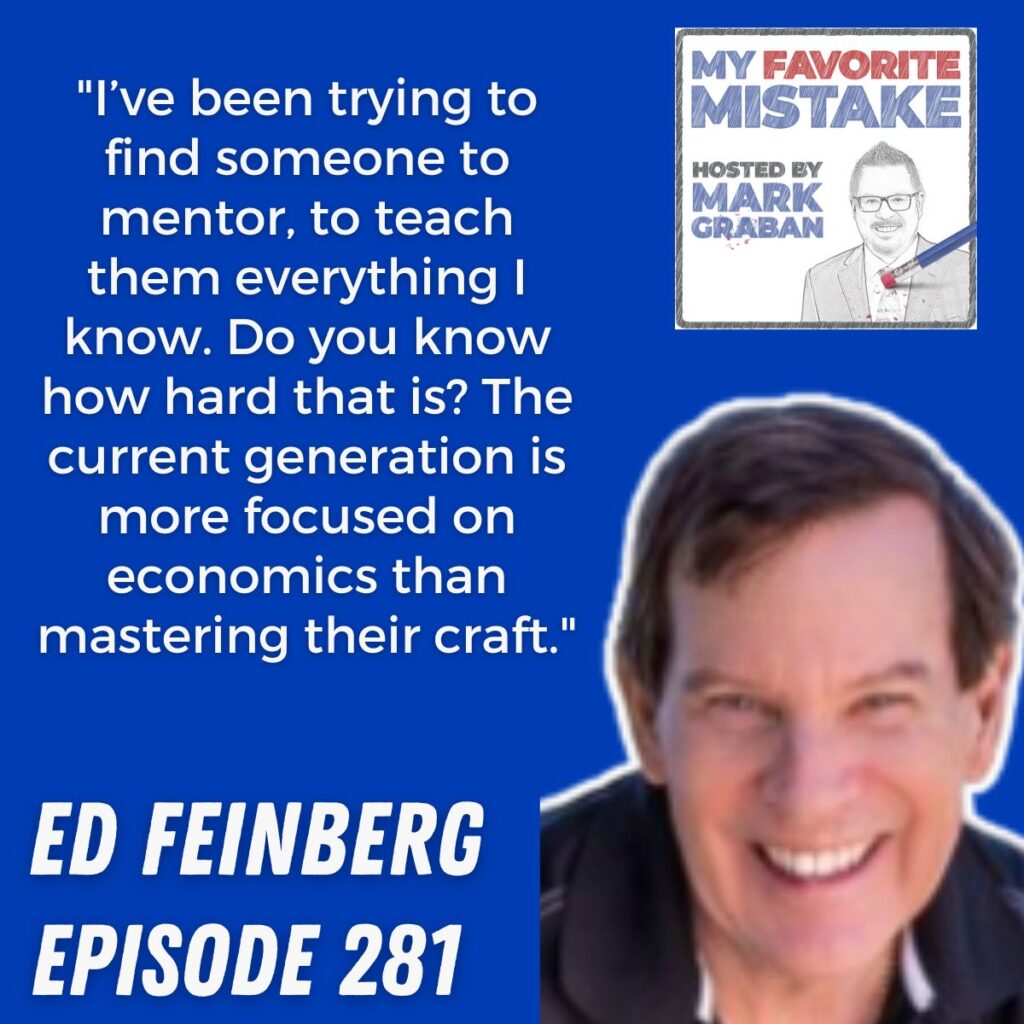
Subscribe, Follow, Support, Rate, and Review!
Please follow, rate, and review via Apple Podcasts, Podchaser, or your favorite app — that helps others find this content, and you'll be sure to get future episodes as they are released weekly. You can also financially support the show through Spotify.
You can now sign up to get new episodes via email, to make sure you don't miss an episode.
This podcast is part of the Lean Communicators network.

Other Ways to Subscribe or Follow — Apps & Email
Automated Transcript (May Contain Mistakes)
Mark Graban:
Hi, welcome to My Favorite Mistake. I'm your host, Mark Graban. Our guest today is Dr. Edward Feinberg, a distinguished expert in restorative dentistry who's dedicated over 40 years to advancing dental care. Dr. Feinberg graduated from Tufts University and was then trained by his father, Dr. Elliot Feinberg, who was a pioneer in full coverage restorative dentistry. He practiced in Scarsdale, New York, before moving to Arizona, where he continues his work. Dr. Feinberg is the director of Onward, an online teaching organization for full coverage restorative dentistry, where he's created over 30 courses. He's also a nationally recognized lecturer and author. His essay collection, Open Wide: Essays on Challenges in Dentistry to Achieve Excellence, is another contribution to the field, and he's served on editorial boards for various dental associations. Dr. Feinberg, welcome to the show. How are you?
Dr. Edward Feinberg:
I'm fine, and you? Thank you.
Mark Graban:
Yeah, I'm doing great. So, as we always do, I'll ask you the key question to kick things off: What would you say is your favorite mistake?
Dr. Edward Feinberg:
Well, you know, my background is such that I can save a lot of teeth that most dentists are extracting. My approach to saving teeth that are flush with the gum is completely different from what's being taught. While the entire profession is focused on tooth structure above the gum, I focus on what's below. I make all my crown and bridgework fit precisely and let patients wear them on a trial basis with something like rubber or Vaseline before cementing them. So, I had a patient, a dentist friend from Brooklyn, and I made a crown for him. And guess what? It fell out. I was mortified because this was someone I wanted to impress.
Mark Graban:
Was that the first time that had happened, or was it just very rare?
Dr. Edward Feinberg:
No, it had happened before, but there's always a reason when something goes wrong. If you can identify the reason, you can correct it. In this case, I didn't get enough grip on the root, so the crown didn't fit tightly. That’s almost always the reason. So, I had to do a little bone work, made a new crown, and let him wear it with Vaseline until I was satisfied. Then I cemented it in permanently. That’s how I do all my dentistry. But it's a learning opportunity—whenever something fails, I want to know why.
Mark Graban:
So, were you able to put some checks or mistake-proofing in place to make sure that didn’t happen again?
Dr. Edward Feinberg:
Yes. I have a step-by-step protocol so that if an error occurs, I can identify it before moving to the next step. That’s how I ensure a perfect result. But sometimes, being human, you miss something. When you make a mistake, it’s a chance to learn and improve. That’s why I’m not so upset when things go wrong—it means I can correct it and prevent it from happening again.
Mark Graban:
That’s a good attitude. And when you were telling the story, it got me thinking—when I had a crown, I worried the temporary one would fall off. Do you use different methods for temporary crowns to prevent that?
Dr. Edward Feinberg:
Yes, I use copper bands to make temporaries, and they fit like permanent restorations. They don’t fall out. Copper is antibacterial, so it prevents decay even if a patient delays returning. I've had patients wear temporary crowns for up to four years, and their teeth were clean when they came back. It's not a method taught in dental schools anymore, but it’s very effective.
Mark Graban:
That’s fascinating. I didn’t realize there were techniques that aren’t being taught anymore. You’ve mentioned before that dental education isn't teaching some of the best methods for tooth preservation. Could you explain more about that?
Dr. Edward Feinberg:
Yes, in my area of dentistry, things have gone backward. Technology like crowns made in an hour seems like an improvement, but it actually violates basic principles that allowed my father and me to succeed. I have 70 years of documentation showing cases that last 30 to 40 years with minimal changes in the periodontal bone. Very few people can show that kind of success. Dental schools have started teaching easier techniques, and students don’t realize there are better ways. This is particularly true in crown and bridgework.
Mark Graban:
It sounds like you're saying there’s a lot of over-reliance on implants in modern dentistry, which leads to mistakes. Could you elaborate on that?
Dr. Edward Feinberg:
Yes, implants are being overused, and I believe teeth should be saved first whenever possible. The issue is that implants are being used as a one-size-fits-all solution, but they don’t solve the patient’s overall problems. They only fill a gap. In many cases, doing good bridgework could fix the entire area and prevent future problems. But very few dentists know how to do proper bridgework anymore. Implants can fail, and when they do, the patient may not be a candidate for new ones. It’s a piecemeal approach to dentistry.
Mark Graban:
That’s interesting, especially when you mention the piecemeal approach. Are you seeing cases where patients are suffering long-term because of this?
Dr. Edward Feinberg:
Yes, I see it all the time. People think implants are a panacea, but that’s not true. Implants are feats of engineering, and they are subject to the same laws. If you don’t put the implants in deep enough or place them at the wrong angles, they will fail. I’ve seen many cases where patients had all their teeth extracted and implants put in without following proper protocol. Often, the implants fail because they can’t handle the load, and by then, the patient’s ridges are ruined, so they can’t even wear dentures.
Mark Graban:
Wow. I’m curious—are these dentists held accountable when things go wrong?
Dr. Edward Feinberg:
It depends. If a dentist truly believes they’re doing the right thing, it’s hard to hold them accountable. But there are cases of malpractice where dentists are using inappropriate techniques. The problem is that many dentists only know how to do one thing, like implants, so that’s what they offer. They can’t see the overall picture. It’s not about doing what’s easy; it’s about doing what’s right for the patient.
Mark Graban:
That’s a great point. You also mentioned earlier that prevention is everything. What advice do you have for patients on maintaining their dental health?
Dr. Edward Feinberg:
Prevention is key. Regular hygiene visits are crucial because they prevent plaque and tartar from building up, which can lead to periodontal bone loss. Once bone is lost, we don’t know how to grow it back. If you maintain good hygiene, you can hold onto your teeth for life.
Mark Graban:
That’s great advice. So, to wrap up, I know you’re passionate about teaching the next generation of dentists. What’s your experience been with younger dentists in terms of their willingness to learn from you?
Dr. Edward Feinberg:
Sadly, I haven’t found many young dentists who want a mentor. Today, a lot of them are more concerned with economics than improving their skills. They graduate with half a million dollars in debt and feel pressured to start making money right away, so they don’t invest in learning better techniques. It’s frustrating because dentistry should be about constantly improving and bettering yourself. But I’m hopeful that those who want to practice good dentistry will find the right mentors.
Mark Graban:
Well, Dr. Feinberg, thank you so much for sharing your insights and perspectives. I’m sure our listeners will benefit from everything you’ve discussed today. The website is onwardprogram.com, and I’ll put links in the show notes. It’s been a pleasure having you on the show.
Dr. Edward Feinberg:
Thank you, Mark. I think you were a terrific interviewer, and I really enjoyed it.
Episode Summary and More
The Evolution and Importance of Full Coverage Restorative Dentistry
Introduction to Full Coverage Restorative Dentistry
Restorative dentistry, specifically full coverage restorative dentistry, has been a cornerstone of effective dental care with experts dedicating decades to its development and improvement. Renowned professionals like Doctor Edward Feinberg have significantly influenced this field through extensive practice, teaching, and continual innovation. Having graduated from Tufts University and trained by his father, Doctor Elliot Feinberg, a pioneer in the domain, Ed now directs Onward, an online teaching organization with over 30 courses on full coverage restorative dentistry.
Historical Perspectives and Innovations
Full coverage restorative dentistry traditionally involves the techniques of creating crowns and bridges to restore the function and aesthetics of teeth. Doctor Edward Feinberg emphasizes a distinct approach, focusing on saving teeth that many dentists might otherwise extract. This methodology diverges from the conventional wisdom that prioritizes the visible tooth structure above gum level. Instead, Feinberg's technique concerns itself with the health and stability of the tooth below the gum line.
Ed elaborates on his method in which crowns and bridges are trial-fitted using materials like rubber or Vaseline to ensure their durability before final cementation. This approach allows patients to wear these restorations on a temporary basis, confirming their effectiveness and comfort. Such meticulous attention ensures minimal complications and long-lasting dental health.
Trends in Cosmetic Dentistry
Cosmetic dentistry has witnessed several trends and developments over the years. According to Dr. Feinberg, there is an increasing inclination towards dental extractions and implant placements. However, he argues for a more conservative approach, advocating for the preservation of natural teeth wherever possible. His perspective suggests that, while dental implants can be beneficial, their overuse can lead to unnecessary complications and expenses for patients.
Dr. Feinberg cautions against the common practice of placing single tooth implants among existing natural teeth, especially when other teeth are compromised or likely to need crowns. He champions the practice of bridge work, where appropriate, as it offers a comprehensive solution that can enhance the dental structure and overall oral health.
Addressing Common Mistakes in Dentistry
An essential part of progressive dental practice is learning from mistakes and continuously improving techniques. Dr. Feinberg shares anecdotes from his practice where crowns fell out, leading him to refine his methods. He identifies exact causes, such as insufficient grip on the tooth root, and rectifies them by enhancing his protocols and procedures.
Ed's philosophy emphasizes the need to view errors as learning opportunities. By diagnosing issues at each step, dental practitioners can avoid repeating mistakes, ensuring better outcomes for patients. This methodical approach aligns with the principles of quality improvement found in many medical disciplines.
Advanced Techniques and Patient Care
In the context of temporaries and permanents, Dr. Feinberg uses copper bands to create temporary restorations that fit securely and maintain the health of the tooth underneath. This technique prevents issues like tooth decay during the interim period before the permanent crown is placed. The antibacterial properties of copper make these temporaries exceptionally effective, minimizing the risk of infection.
Dr. Feinberg draws an analogy to mason jar covers, a time-tested method for preserving contents, illustrating the meticulousness and thought behind his restorative techniques. This reflects a commitment to maintaining oral health through both scientifically proven methods and innovative practices derived from foundational principles in dentistry.
Dental Education and Evolution
The landscape of dental education is diverse, with significant advancements in certain areas like endodontics and orthodontics. However, Dr. Feinberg points out a regression in the teaching methods for full coverage restorative dentistry. Modern techniques often prioritize ease of teaching and learning over the effectiveness and longevity of restorative procedures.
Dr. Feinberg's extensive documentation, including over 100,000 photos spanning decades, provides empirical evidence of his successful methodologies. This invaluable resource underscores the necessity for continual education and openness to new, albeit sometimes traditional, approaches to dental care.
The Value of Second Opinions
A critical takeaway from Dr. Feinberg's experience is the importance of seeking second opinions. Patients often accept the recommendations of their primary dentist without realizing that alternative, potentially less invasive options may exist. In medicine, second opinions are common, and applying this practice to dentistry could lead to better patient outcomes and satisfaction.
Dentists, akin to doctors, have varying levels of experience and expertise, making it worthwhile for patients to explore different perspectives, especially for complex dental issues. Dr. Feinberg advocates for patient-centered care, prioritizing the most appropriate treatment plans tailored to individual needs.
Conclusion
Dr. Edward Feinberg's profound contributions to full coverage restorative dentistry emphasize the importance of saving natural teeth, learning from mistakes, and continually refining dental techniques. His innovative methods and dedication to patient care provide valuable insights into the evolving field of restorative dentistry, highlighting the need for both historical knowledge and modern adaptability in dental practice.

